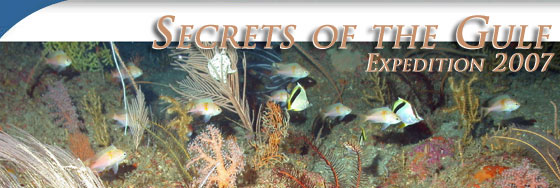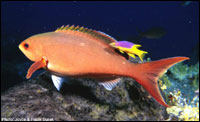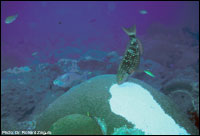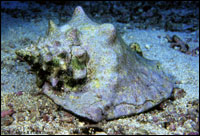 | ||||||||||||||||||||
|
|
|
|
|

Mission Log March 6, 2007
by Emma Hickerson |
||||||||||||||||
 |
| This small Spanish hogfish is picking parasites from the larger creole fish at a cleaning station on the reef. For this moment in time, there is a truce in the predator-prey relationship. The larger fish, which might ordinarily eat the smaller one, remains still and allows the smaller fish or shrimp to pick off parasites and bits of dead skin. Big fish gets rids of an irritant; little fish gets a meal. Everyone is happy. The presence of cleaning stations and the number of species involved is one of many indicators used to assess the reef's health. Dr. Mary Wicksten's documentation of cleaning stations in the sanctuary will help managers determine the health of the Flower Garden Banks' reefs. |
Today, we spotted a manta with a tag. We know it traveled from another bank because we have not yet tagged a manta at West FGB. When we downloaded data from the acoustic receiver, tags from different mantas were recorded. Two of them were tagged at East FGB. The third was tagged at Stetson Bank and traveled all the way to West FGB - that's 30 miles! We are eager to visit East FGB to download the receiver there and discover what additional clues the tagged mantas will reveal.
Dr. Craig Burnside and Jenna Fulgham are conducting conch surveys and located three conch that were tagged previously, one as long as two years ago.
Dr. Andy Bruckner and Eric Borneman are studying coral diseases. Their surveys today revealed some active white plague like disease, but it does not appear to be as bad as last year's outbreak. (To learn more, refer to the State of the Sanctuaries Report and read Scientists Monitor Reefs Following Natural Impacts and associated links.) Dr. Bruckner is also investigating parrotfish predation of coral. He noted parrotfish bites on some coral heads at previously established stations.
 |
| Parrot fish are generally herbivores (plant eaters). Sometimes, though, you have to grab a little meat with your vegetables. Parrot fish often munch on coral polyps to get to the algae that lives inside the coral tissue. In the process, their large, blunt teeth bite into the coral's hard skeleton as well. You can see in this image where the parrot fish has grazed The fish digests the algae and excretes the ground up skeleton as white sand. What role do parrot fish play in the coral reef's health? Are they eating mostly diseased coral? Or are they eating healthy coral? Do they help maintain the balance between algae and coral on the reef? These are questions that scientists like Dr. Bruckner hope to answer with their research. |
Additional general observations included:
- visibility was about 60 feet
- 10 to 12-foot-long tiger sharks
- spinner sharks jumping on surface
- loggerhead turtles on surface
- large black groupers on reef
- small schools of large amberjacks
- cleaning stations (places on the reef where large fish visit to allow smaller fish or shrimp to pick parasites from their gills, mouth and body)
Tomorrow, we will rendezvous with the SSV Carolyn Chouest to transfer personnel so that researchers from the MV Spree can participate in the scheduled broadcasts. Geologist Mark Betts and biologist Doug Weaver will exit the NR-1 and archaeologist Jack Irion and geologist Kat Cantner will take their places. It will be exciting to hear what Mark and Doug saw during the time on the submarine!
|
|





